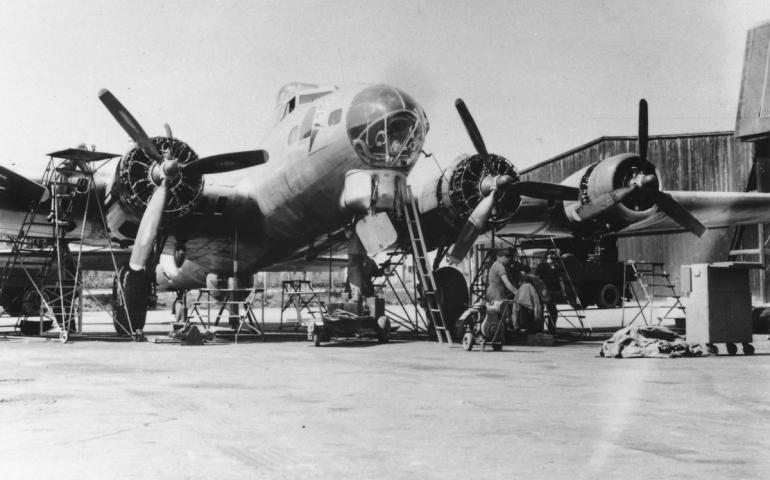
Between 1943 and 1945, 166 American bombers took refuge in Switzerland, 41 of which were destroyed in crashes or crash landings. 39 bombers suffered heavy damage and another 86 aircraft suffered light damage. In November 1944, a five-man delegation from America arrived in Switzerland to advise our mechanics and specialists on aircraft maintenance. The head of the delegation, Lieutenant Colonel Peter DePaolo, described the condition of the parked aircraft as very good and found that virtually all of them could be flown back after appropriate overhaul work. However, the 39 dismantled bombers and fighters were deemed not repairable, which were dismantled by the Swiss Army for lack of space and because of their damage and then stored in hangars at Dübendorf and Kloten. These aircraft fell victim to the cutting torch after the war. On the arrival of the American staging detachment with four C-87 Liberators and two Douglas C-47s, a serious accident occurred on August 18, 1945, during the landing of the first aircraft, when the C-87 crashed into the Dietlikon forest after a failed takeoff maneuver. Four crewmen met their deaths, only two crewmen could be recovered slightly injured. The remaining aircraft brought tools of all kinds, hydraulic lifting equipment, compressors and fuel and lubricants to Dübendorf. By the end of the transfer operation, another 290 American transport planes had landed and brought in bomber crews, spare parts and 100,000 liters of fuel. More than 120 American soldiers supported the 150 men from Swissair and the Swiss Air Force. They took care of the repairs and readiness work on the bombers. Most of the refurbishment work on the B-17s and B-24s involved overhauling the engines and checking the instrumentation, radios, landing gear and electrical systems. Engine changes had to be made on 19 B-17s and 25 B-24s, using engines from aircraft to be scrapped. Minor damage also had to be repaired on most of the bombers. An average of 200 hours was spent on each aircraft. At the end of August, the first bombers, all B-17s, were able to return to England. The unfavorable space conditions only allowed takeoffs with low payloads. Therefore, the tanks were filled with a minimum of gasoline to reach Munich-Erding or Paris-Villacoublay. There, the interned aircraft were fully refueled for the onward flight to Burtonwood. The airfield in England was the major depot of the U.S. Army Air Force during World War II and employed up to 25,000 men. About eight bombers could be made ready for flight each week at Dübendorf. In the case of the B-24s, control flights were partially omitted in view of the inadequate dimensions of the Dübendorf airfield. On October 20, 1945, the last three interned aircraft, two B-24s and the only airworthy Mustang took off for Burtonwood via Paris. The Mustang pilot said goodbye to Switzerland in his own personal way. After marking a few low-level attacks over the Dübendorf airfield, he flew to Zurich to fly directly over the houses several times along the Bahnhofstrasse. This cowboy interlude capped off some extraordinary incidents during the return of the bombers. On August 27, 1945, immediately after takeoff, the upper gun turret of a B-17 became independent and struck the road in the western part of Dübendorf. The nose gear of the Liberators was designed only for operation on hard-surface runways, so when landing on the short (by American standards) grass runways at Dübendorf, Altenrhein or Payerne, the nose wheel often broke off at first contact with the ground. Between August and the end of October 1945, 41 Liberators left Switzerland by air via Munich-Erding or Paris-Villacoublay for Burtonwood, where all the interned bombers fell victim to the scrap press. Their non-airworthy sisters had already met the same fate weeks earlier in Switzerland. During the ferry flight of the "Belle Ringer", a B-24, the pilot got caught in a bad weather front and had to make an emergency landing near Paris, which the three-man crew survived unharmed, but the Liberator was completely destroyed. A total of 69 American aircraft were flown over to Burtonwood, including 29 B-17s,39 B-24s and one Mustang. The Stinson, which made a forced landing in Switzerland, was purchased by the Swiss Air Force. By the time the formerly interned aircraft had reached their home in England, the ferrying of American bombers to the United States had been completed. The bombers, which had been carefully maintained by our people over the years of the war and which had been prepared for the flight to Burtonwood at great expense, came under the sledgehammer shortly after their arrival. They shared their fate with hundreds of Mustangs, Thunderbolts and Lightnings that had arrived from America brand new and were immediately.
Source: H. Stapfer